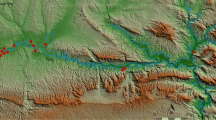Abstract
Kavala, initially founded as Neapolis in the seventh century BC, and later called Christoupolis, has flourished as an important urban center and port in Eastern Macedonia, Greece, during many historical periods. In this paper, we study the remnants of its historical aqueduct, which carried water to the city from mountainous springs at a distance of 6500 m from the city walls. Our study includes: (a) archeological evidence regarding its construction period, which shows that it was initially constructed during the late Roman era and was heavily reconstructed by the Ottomans, in the first part of the sixteenth century ad, and (b) new topographical measurements and hydraulic calculations, aiming at drawing conclusions, mainly on its carrying capacity. Taking into account the preserved parts of the aqueduct’s channel only, we have estimated that its carrying capacity was quite large, with regard to the population that it was supposed to serve. Moreover, we have delineated the city area that the aqueduct could not serve directly, due to ground elevation differences.










Similar content being viewed by others
References
Angelakis A, Mays NW, Koutsoyiannis D, Mamassis N (2012) Evolution of water consumption through the millennia. IWA Publishing, London
Bakalakis G (1936) Neapolis–Christoupolis–Kavala. Archaelogiki Efimeris (Archael J) 75:1–48 (in Greek)
Bakalakis G (1938) The next-to-Christoupolis wall. Ellinika 10:307–318 (in Greek)
Bakirtzis Ch (1980) Byzantine Kavala: archaeological survey. In: Kavala and its area. Proceedings of institute for Balkan studies first regional symposium, Thessaloniki, pp 527–528 (in Greek)
Belon P (1554) Les observations de plusieurs singularitez et choses mémorables trouvées en Grèce, Asie, Judée, Égypte, Arabie et autres pays estranges, rédigées en trois livres. Paris
Christaki M, Stournaras G, Nastos PT, Mamassis N (2017) Water supply associated with the development of the city of Athens from the Hellenistic era until the end of the 19th century. Water Hist 9(4):389–410. https://doi.org/10.1007/s12685-017-0197-y
Crow J (2012) Ruling the waters: managing the water supply of Constantinople, AD 330–1204. Water Hist 4:35–55
Crow J, Bardill J, Bayliss R (2008) The water supply of Byzantine Constantinople. Society for the Promotion of Roman Studies, London
Dadaki S, Iliadis E, Iliadis I (2016) Distance water carriers in the Roman period. The case of Philippi and Neapolis-Kavala. III International Congress Santuários, Cultura, Arte, Romarias, Peregrinações, Paisagens e Pessoas
De Feo G, Angelakis AN, Antoniou GP, El-Gohary F, Haut B, Passchier CW, Zheng XY (2013) Historical and technical notes on aqueducts from prehistoric to medieval times. Water 5(4):1996–2025
Dimitriadis V (1983) Topography of Thessaloniki during the Ottoman period 1430–1912. Society for Macedonian Studies, Thessaloniki (in Greek)
Dvornik F (1926) La vie de saint Grégoire de Décapolite et les Slaves Macédoniens au IXe siècle. Travaux publiés par l’Institut d’études slaves, V, Paris, p 1926
Fatouros G (ed) (1992) Theodori Studitae Epistulae De Gruyter. Berolini/Novi Eboraci, Berlin/New York
Gala-Geogrila E (2015) Trails of water and organization of space on Thessaloniki during the middle and later Byzantine period 2 vols, PhD thesis, Aristotle University of Thessaloniki (in Greek)
https://deyakav.gr//το-νερό-στην-καβάλα/. Assessed 23 August 2019
Katsifarakis KL, Avgoloupis I (2013) A new approach to the description of a Babylonian hydraulic work by Herodotus. Class Q 63(2):888–891. https://doi.org/10.1017/s0009838813000360
Katsoni P (2003) Ottoman conquests in Byzantine Macedonia—the case of Christoupolis. Byzantina 23:191–208 (in Greek)
Keilholz P (2017) Water supply and distribution in the ancient Decapolis city of Gadara. Water Hist 9(2):147–168. https://doi.org/10.1007/s12685-016-0178-6
Kiel M (1992) Remarks on some Ottoman-Turkish aqueducts and water supply systems in the Balkans—Kavalla, Chalkis, Levkas and Ferai/Ferecik. In: Vandamme M (ed) De turcicis aliisque rebus: Commentarii Henry Hofman dedicati. Instituut voor Oosterse Talen en Culturen, Utrecht, pp 105–139
Kiel M (1996) Ottoman building activity along the via Egnatia, the cases of Pazargah, Kavalla and Ferecik. In: El Zachariadou (ed) The via Egnatia under Ottoman Rule (1380–1699). Crete University Press, Rethymnon, pp 145–158
Koukouli-Chrisanthaki H, Tsouris K (1986) In: Archaeologikon Deltion - Chronika, 41:175–176 (in Greek)
Koutsoyiannis D, Zarkadoulas N, Angelakis AN, Tchobanoglous G (2008) Urban water management in ancient Greece: legacies and lessons. J Water Resour Plan Manag 134(1):45–54
Lazaridis D (1969) Neapolis Christoupolis Kavala—Kavala Museum Guide. Athens (in Greek)
Lowry H (2008) The shaping of the Ottoman Balkans 1350–1550. Bahçeşehir University Publications, Istanbul
Lychounas M (2008) Medieval aqueduct of Kavala—Kamares. Greek Ministry of Culture—12th Ephorate of Antiquities, Kavala (in Greek)
Manoledakis M (2018) The water supply of Roman Thessaloniki. Great waterworks in Roman Greece. Archaeopress Publishing Ltd, Oxford, pp 50–69
Mertzios K (1947) Monuments of Macedonian history. Society for Macedonian Studies, Thessaloniki (in Greek)
Moshopoulos N (1938) Greece as described by Evliya Celeby. J Soc Byz Stud 14:486–514 (in Greek)
Reinach S (1882) La reconstruction des murs de Cavalla au 10e siecle. BCH 6:267–275
Stefanidou A (1991) The city-port of Kavala during the Ottoman period—Urban Planning Investigation (1391–1912.) PhD Thesis, Aristotle University of Thessaloniki (in Greek)
Tsouris K (1998) Neapolis–Christoupolis–Kavala. Corrections—Additions—Observations at fortification and water supply. Archaelogikon Deltion 53—Studies 387–454 (in Greek)
Vacalopoulos A (1973) History of Makedonia 1354–1833. Institute for Balkan Studies, Thessaloniki
Acknowledgements
The authors are indebted to Mr. Prodromos Moutsokapas, for conducting additional topographical measurements.
Author information
Authors and Affiliations
Corresponding author
Additional information
Publisher's Note
Springer Nature remains neutral with regard to jurisdictional claims in published maps and institutional affiliations.
Rights and permissions
About this article
Cite this article
Dermentzoglou, D., Dadaki, S., Avgoloupis, I. et al. Technical study of the historical aqueduct of Kavala, Greece. Water Hist 11, 233–252 (2019). https://doi.org/10.1007/s12685-019-00238-z
Received:
Accepted:
Published:
Issue Date:
DOI: https://doi.org/10.1007/s12685-019-00238-z




